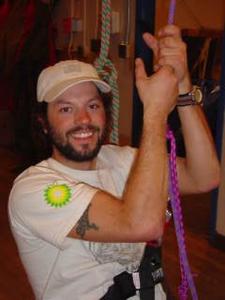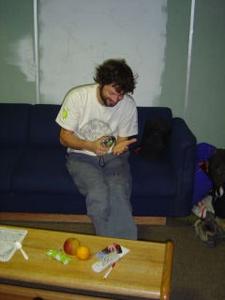27 November, 2003
Meet the team.
Since our preparation is now complete and we only await field deployment, I thought I would take this time to have you all get acquainted with the members of the team.
The technician in the group is Kevin Kruger, a 28-year-old Alberta, native with a delightful accent to match. His job will be to safely extract the fossil remains and prepare them for shipment. A quick witted fellow, he always has a different perspective to add to conversations and his many talents are often called upon as we prepare for the Beardmore. It is rare to find him without a smile, and he is a delight to know. I am sure I will continue to learn a lot from him as the expedition continues.
Kevin started his professional journey during his undergraduate studies at the University of Alberta, where he was enrolled as a Geochemistry major. He was intrigued by evolution however and took some paleontology courses and soon became hooked. Changing majors, he graduated in 1998 with a double major in Geology and Zoology.
Upon graduation, he landed a summer job at Royal Tyrrell Museum in Alberta, Canada. This was a natural fit since Alberta was once a dinosaur paradise. Its climate was much different from today, it was a warm-temperate climate full of lush vegetation which was food for herds of herbivores who became ample prey for the carnivores creating one of the best deposits of late Cretaceous dinosaur fossils found anywhere in the world.
Kevin joined crews from the Tyrrell Museum who hunted for new fossils to add to their collection. Picking up tricks of the trade from those experienced preparators and technicians around him he helped add to a collection that has close to 40 dinosaur skeletons on display that you can admire up close, and more than a 110,000 other specimens in the collection. Since he did not have to go back to school in the fall, he was able to stay on at the museum and it grew into a full time job. He so enjoyed the hands on aspect of the work that he decided not to continue on with grad school but to spend his time building his skills and reputation as an expert technician. This year, Kevin went out on his own which allows him to pick and choose jobs that pique his curiosity. In addition to his field work organizing and helping researchers remove their fossil finds, he also prepares thin-sections and petrographic slides at his workshop in Drumheller, Alberta. On occasion, he gets to do a reconstruction or make castings of the fossil remains he works on. "That's a real treat, to reconstruct a creature from the scattered fossilized remains and see how the organism looked all put together."
Kevin said one of his biggest challenges was to remove a skeleton belonging to a member of the Ceratopsidae Family or Horned Dinosaur from Dinosaur Provincial Park in Alberta, Canada. They took it out in three blocks, the first weighing between two and three tons, the second about one ton and the third about 500 pounds. The size and weight made moving it along the crested hills (an erosional land form) quite tricky.
Kruger has been all over the United States and Canada employing his parcticular expertise to help Paleontologists remove their finds from the field and get them to their labs for further study. He has also spent some time in Japan helping exhibit fossil displays. Kevin's suggestion for budding scientists is to try to apprentice yourself to a tech or paleontologist as soon as possible to see if this is the field you really want to be in. He loves his work because it allows him to put all his passions together, study paleontology, be outdoors in exotic environments, work with world class professors, and best of all, be a part of important work, safely extracting and preserving our Earth's history.
Now Kevin will have to bring all his expertise to bear on this expedition. He will be extracting the remains of the Cryolophosaurus found on Mt. Kirkpatrick, Antarctica. He will be working at an altitude of around 12,800 feet in temperatures that will be around
-25 degrees C. Using a small gasoline powered jack hammers called Punjairs, he has to carefully breakout the dinosaur's fossil remains from the mudstone it is encased in, making the sections large enough so not to destroy the fossils, yet small enough so our helicopters that are operating at nearly their maximum altitude, will be able lift them off the mountain and return them safely to base camp on the Beardmore Glacier.
When I asked Kevin what he thought of this expedition, he remarked, "It doesn't get any better than this!" I have to agree
Tomorrow, Nate Smith, Graduate student par excellence!

Kevin practices his ascending techniques.

Kevin works on his camera. "What do you mean they can't survive a fall into a crevasse?"
Contact the TEA in the field at
.
If you cannot connect through your browser, copy the
TEA's e-mail address in the "To:" line of
your favorite e-mail package.
|
